|
Sacred and
Profane -
Tel Aviv, Metulla
& the Golan Heights, Israel
Greeting
from the Holy Land!
note:
it with such sadness that we watch the violence raging anew across the
region that began in mid 2000. Our visit was during a time of relative
peace that many hoped dearly would last. As the region is swallowed up
in spiral of violence, we look back at our fond memories of this deeply
historic and spiritual place, and we pray that peace will come again. We
hope that all parties will find a way to live and worship together and
see each other as
one and the same, a part of all humanity.
What a great time to be here while history is in the
making. For the first time in a long time, peace is
on the horizon. Israel embarked on this course, first
making peace with Egypt, then Jordan, and now six years ago, signing the historical Oslo peace accords,
setting in motion a plan to make peace with the
Palestinians, headed by Yassar Arafat, head of the formerly
underground, PLO.
Of course, the peace
process is fraught with risks and perils. Israeli
prime minister Rabin was
assassinated four years ago, and the occasional suicide bomber strikes hoping to
derail the peace process, but still it moves on and gains
momentum. There are even hope that peace may be had with Syria
and Lebanon, ending the state of war on Israel's
borders, but time will tell.
To see it first hand
is absolutely fascinating.
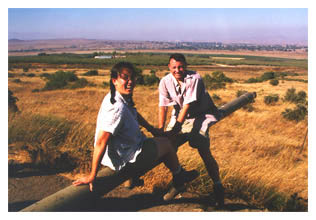
Ann
and Doug heading off to Syria at the Purple Line
We landed at the Tel Aviv Airport and went through a
long and thorough security check, immigration and customs. Already, we
can feel the tension in the air. From the first moment we stepped foot in
Israel, the difference is palpable and very obvious, namely
the guns. Since Israel has been in a state of war with any number of neighboring countries since its
foundation in 1948, there is mandatory conscription,
meaning every boy and GIRL must join for three years
upon completion of secondary school (high school).
It is most disconcerting to see young kids slinging
M-16 assault rifles at the mall. Especially the
girls.
How's that for equality? When we look at them, they
look so young and they are (18-21 years old)
The girls wear makeup and do up their hair, then
don fatigues and a machine gun and head out. Most of
the time, they wear their army issued green clothing,
but we have also seen young kids in regular dress
(baggy shorts and t-shirt) that still sport a gun
that is almost as big as they are (M-16 are 3 and half feet long). They
seem normal enough from the front, until they turn and you see their
weapon of mass destruction, slung casually across their back.
Disconcerting to say the least, but
worse, we are actually getting used to it.
Having
talked to quite a few soldiers, they are great and cannot wait
to be done with it all. We hope they stay safe and
that the peace comes to the region, but until then, you have to fight for your
beliefs and your right to even exist. That air of paranoia will take a
long time to dissipate, if ever. But once out in Tel Aviv, the political
realities seemed, at least, a little further away.
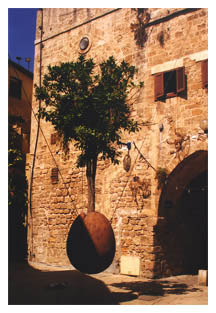 The
artist community of Jaffa The
artist community of Jaffa
Tel Aviv is the middle east Miami.
The waterfront, the promenade, the ritzy, glitzy shopping arcade,
the chic restaurants, the abundance of pastel architecture and of
course, the body conscious people strolling through it all. All flash and dash for a modern city with almost no history. People pursue
recreation with a vengeance, in reaction to such
overwhelming tension.
How does one live life under a constant threat of annihilation? Party
like it's 1999...
The other unique thing about Israel
is that, as a
Jewish nation, religion and government are
intertwined
making for conflict and contradiction in the sacred and the
secular.
Shabbat, the
Jewish holy day of rest begins on Friday at sundown
and continues til Saturday at sundown.
At that time,
the cities are deserted. No public transportation
runs, all the stores are closed, and no one walks the
streets, except for the stray traveler such as ourselves looking hungrily for any restaurant or
even a mini-mart that is open. If you don't eat before
sundown, you don't eat.
We found one restaurant shortly before sundown. We ate quickly, then as
we were finishing our meal, the owners hurriedly closed the exterior
shutters to avoid the appearance of being open and politely ask us to
hurry and finish and leave.
Speaking of the cuisine, the three key words are:
hummos, falafel, and kebob. And thats about it. Its good, but how much of it can you have.
We have
been to a few hummos joints where they slap a plate
of hummos, some raw vegis and a pile of pitas before
you and it's a meal. We are not complaining, but the
other day, we gave in and had a burrito at a tex-mex
joint (it felt good not to have hummos at every
meal.)
So much of the soft, creamy mixture as a staple of our diet, has
seemingly wrecked havoc on our intestinal system and we are in the
throes of digestive woes. Nuf said.
From Tel Aviv, we travelled north to Haifa, where we
met up with Stas, our friend Dmitri's cousin and a Russian
immigrant to Israel after Russia cracked down on its Jewish population
forcing many to flee there and the US.
He
showed us around Haifa (the new Israel silicon
valley)
and we drove out to see some Druze villages (one of
the few Arab communities fully integrated into
Israeli society)
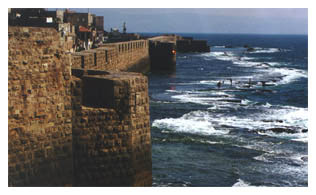
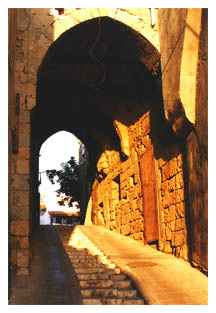 Alley
entering into Acre with side ramps added for cars. Alley
entering into Acre with side ramps added for cars.
From there we headed to Acre, a
small community on the Mediterranean that was still in a time-warp. An old Crusader fortress built by Richard the Lion-Hearted,
it is a stunning city on the water surrounding by
the old defensive walls. The narrow, dusty
streets meandered into dead ends or bustling
souqs (markets), kids on donkeys raced by, and no
sign
of cars or other modern implements.
The community was mostly Palestinean and the town lacked much of the
infrastructure we saw in nearby places like Haifa. It makes for wonderful
tourism but not much else. Many a local can be found on the high rocks
outside the walls of the city, fishing for a day's meal.
From there, so far north in Israel, we decided to visit the more unusual destinations, the areas
plagued
by violence and war. First, we went up to Metulla
on the border with Lebanon.
That is the location of
the Good Fence, so called because Lebanese are allowed to cross into Israel to work, but only
if they have a relative in the South Lebanon Army,
the proxy army of Israel that is fighting the terrorist group, Hezbollah in the security zone.
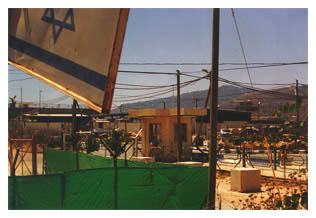
We had lunch with the numerous soldiers stationed there
and from our seats, we had an incredible view of
southern Lebanon.
Just over an hour's drive and we
could be in Beirut. Missiles are occasionally
lobbed over into Metulla, the biggest Israeli city
in the area, to this day, but thankfully we saw no
action.
Lebanese money was touted as souvenirs at the few shops in the
area. Mostly, just lonely soldiers hoping not to be in the wrong place
at the wrong time.
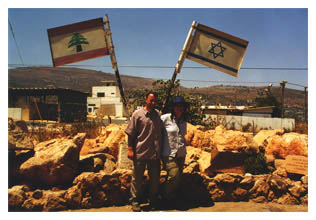
Note:
The SLA was disbanded and the Israeli army retreated in May 2000 and
many Lebanese with ties to the SLA fled to Israel in fear of reprisals.
It came swiftly for those that did not make it out. I am unaware of the
fate of the Good Fence.
From there, we went into the Golan heights,
considered
by some to be occupied territory of Syria. After the
six day way in 1967, the Golan Heights was annexed
by Israel and the Purple Line was drawn (the de-militarized zone.) The unfortunate reality of that is
that lines were drawn through towns and even through
families and neighbors. We visited the shouting
fence, so called because families on both sides of
the
line gather there with megaphones and shout to each
other across the purple line, in order to communicate
and keep in touch.
Such are the realities of war. We waved to
Israeli soldiers above us, then to their
Syrian counterparts across the way and finally to the
UN guys, smack in the middle. It seemed a dead community, its
heart torn out; bodies that go through the motion of life.
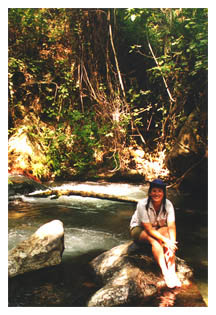 Hiking
in the Golan Heights Hiking
in the Golan Heights
Much of the Golan Heights are deserted. In a largely
deserted region, the Golan Heights is in stark contrast, a lush green
oasis with hiking opportunities for the strong hearted and a good deal
of water reserved. But the importance of the area lies in its strategic
elevation, and the ability to launch operations and strikes against
Israel. Currently, however, there seems to be some hope on the horizen
of Israel reaching some understanding with Syria and establishing
treaties and ties to end the state of war. It is generally understood
that Golan Heights would most likely return to Syrian control under
those circumstances.
Next
episode: We attempt to walk in the footsteps of Jesus
over and
out
ann and
doug
index | back
| next |
